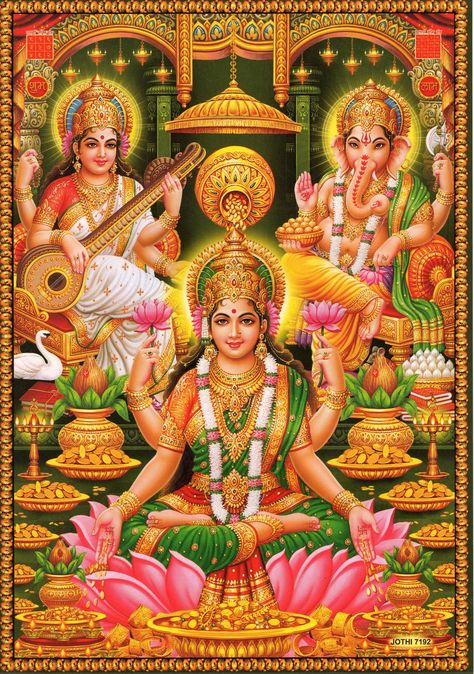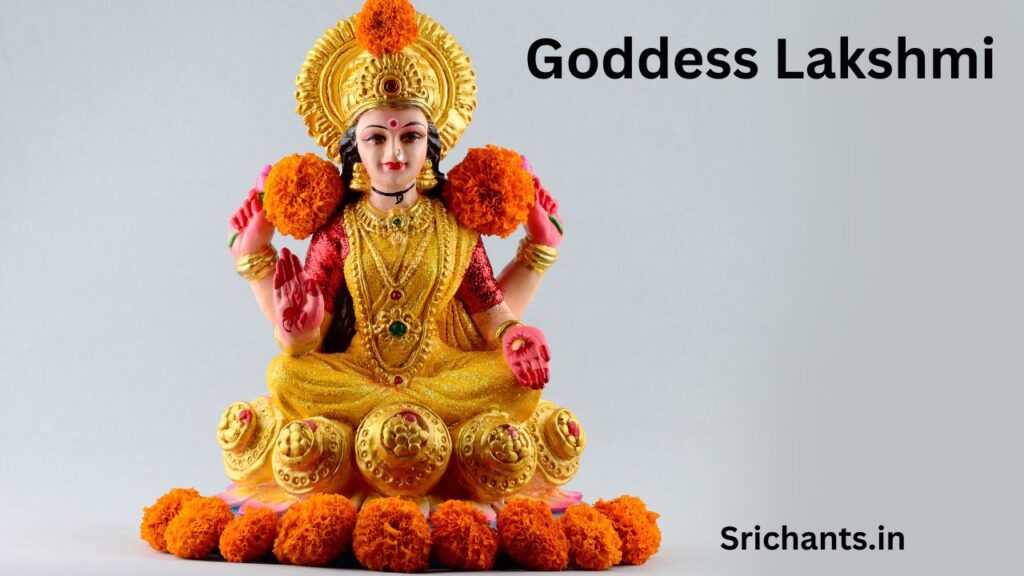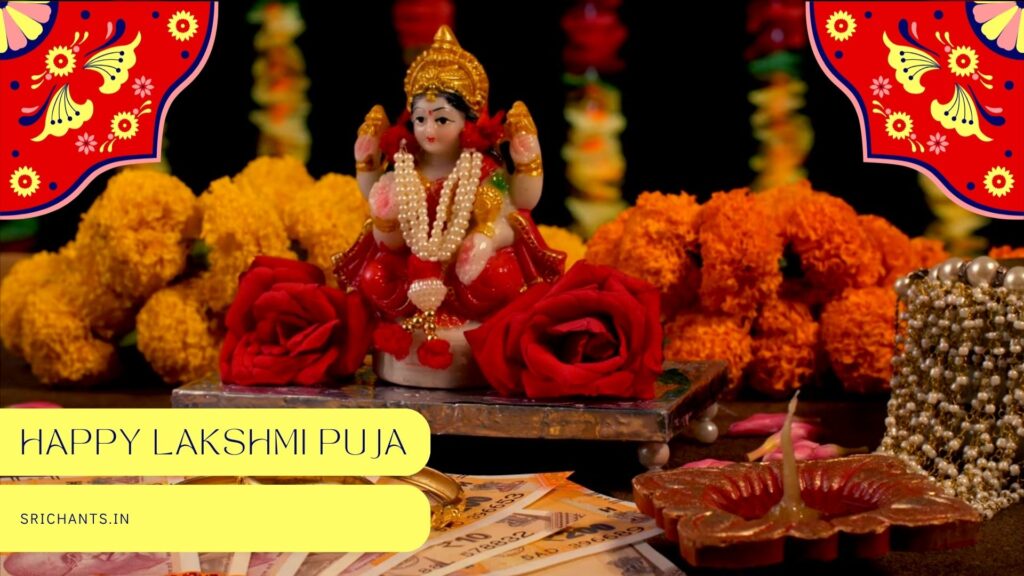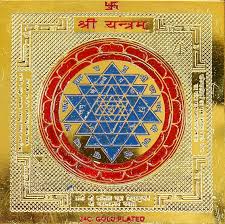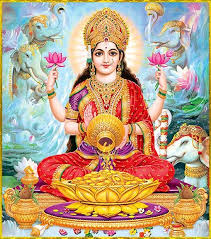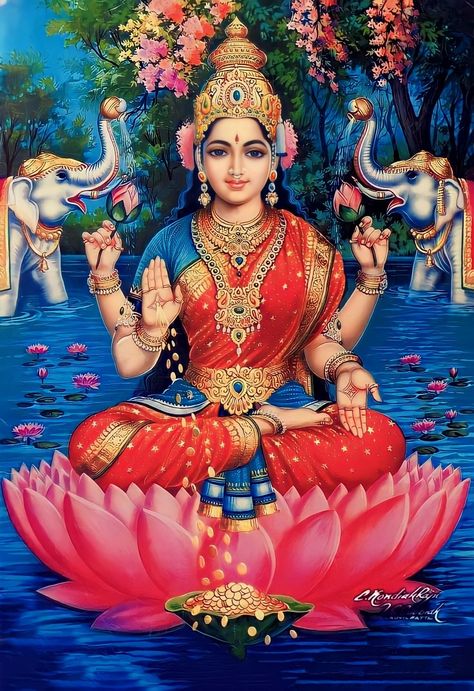Who is Lakshmi ? Goddess of Wealth and Prosperity
Introduction
Each of the deities in the Hindu pantheon embodies a unique aspect of the sacred, forming a rich tapestry. One deity, Lakshmi, is distinctive among this celestial assembly as the embodiment of wealth, prosperity, and abundance. Lakshmi’s influence extends beyond Hinduism, entrancing devotees from diverse faiths and cultures as the consort of Lord Vishnu, the preserver of the universe.
The origins, iconography, and profound significance of Lakshmi in the spiritual landscape of the Indian subcontinent are the focus of this article, which delves into her captivating narrative. The multifaceted substance of the Goddess of Wealth and Fortune will be revealed, from her mythological birth to her enduring presence in the lives of millions.
The Celestial Birth of Lakshmi
Lakshmi’s origins are deeply ingrained in Hindu mythology, and her birth was marked by a significant event in the cosmic history of the universe. As per the Puranas, the ancient Hindu scriptures, Lakshmi was created as a result of the Samudra Manthan, the churning of the celestial ocean of milk. The devas (gods) and asuras (demons) embarked on this monumental endeavor in order to acquire the Amrita, the elixir of immortality.
The radiant deity Lakshmi, who was seated on a magnificent lotus flower, was among the myriad of wondrous treasures that emerged as the ocean was churned. The devas immediately acknowledged her benevolent presence and captivating attractiveness, and they welcomed her with reverence and gratitude. Lakshmi’s arrival was a critical moment, as it was her intervention that ultimately shifted the balance in favor of the devas, allowing them to defeat the asuras and obtain the coveted Amrita.

The Multifaceted Nature of Lakshmi
Lakshmi’s importance in the Hindu pantheon is not limited to her function as the goddess of prosperity and wealth. She is held in high regard as the embodiment of the divine feminine, as she encompasses a wide range of attributes and forms. Lakshmi is referred to by a variety of names in the Vedas, the earliest sacred texts of Hinduism, each of which reflects a unique aspect of her divine nature.
The Three Forms of Lakshmi
Lakshmi is acknowledged to exist in three distinct forms: Shri, Bhu, and Durga, as per the Garuda Purana, one of the most significant Hindu texts. The goddess’s comprehensive divinity is embodied by these three manifestations, which each represent a distinct aspect of her.
- Shri Lakshmi: This aspect of Lakshmi is linked to spiritual wealth, grace, and auspiciousness. Shri Lakshmi is the embodiment of the divine energy that sustains and supports Lord Vishnu, the preserver of the universe.
- Bhu Lakshmi: Bhu Lakshmi is a metaphor for the goddess’s connection to the material world, representing earthly prosperity, abundance, and the bountiful bounties of nature.
- Durga Lakshmi: This manifestation of Lakshmi is linked to the capacity to surmount challenges, fortitude, and power. Durga Lakshmi is the goddess’s wrathful, four-armed incarnation, who wields a variety of weapons to slay evil and restore cosmic equilibrium.
The three distinct forms of Lakshmi, each with its own unique attributes, collaborate to satisfy the diverse requirements and aspirations of her devotees.

Lakshmi’s Avatars and Incarnations
The mythology of Lakshmi is a complex tapestry that extends beyond her primary forms. It is believed that she has assumed a variety of incarnations to accompany Lord Vishnu in his various avatars. This divine partnership is a testament to the profound spiritual connection between the deity and the universe’s preserver.
During Vishnu’s incarnation as the ax-wielding Parashurama, Lakshmi manifested as his consort, Dharani. Vamana, Lakshmi’s dwarf avatar, manifested as Padma or Kamala, emerging from a lotus blossom. Lakshmi assumed the form of his consort, the virtuous Sita, during Vishnu’s incarnation as the venerated King Rama.
In addition to demonstrating her unwavering devotion to her divine counterpart, these diverse incarnations of Lakshmi also demonstrate her capacity to adapt and transform, always present to support and empower Vishnu in his cosmic endeavors.

The Iconography and Symbolism of Lakshmi
The profound symbolism and enduring significance of Lakshmi are exemplified by her visual representation in Hindu art and iconography. The deity is typically depicted as a woman of elegant beauty, with a golden complexion, who is adorned in a vibrant red sari and resplendent gold ornaments. This attire is symbolic of her association with wealth, prosperity, and material abundance.
The four-armed form of Lakshmi is one of the most distinct features of her iconography, with each hand representing a distinct aspect of the human experience. In Hindu philosophy, the four principal goals or “Purusharthas” are purportedly represented by these four hands: Dharma (righteousness), Artha (wealth), Kama (desire), and Moksha (liberation).
Lakshmi is frequently depicted either standing or seated on a lotus blossom, which is a symbol of spiritual enlightenment, purity, and the capacity to transcend the material world. The goddess’s association with fecundity, abundance, and the life-giving power of water is further emphasized by the presence of two white elephants, who typically pour water over her.
The owl, which is occasionally depicted as her vahana or vehicle, is another iconic element associated with Lakshmi. As a reminder to her followers, the owl, which is renowned for its acute vision in the nighttime, urges them to avoid being deceived by greed or material desires and to pursue enlightenment and balance.
The Festivals and Rituals Honoring Lakshmi
The numerous festivals and rituals that are dedicated to Lakshmi throughout the year are indicative of her importance in the Hindu faith. One of the most widely observed and significant festivals is Diwali, which is also referred to as the “Festival of Lights.”
Hindus perform a series of rituals and practices during Diwali to pay homage to Lakshmi and to summon her blessings into their homes and lives. In order to establish a welcoming environment for the deity, homes are meticulously cleaned, adorned with diyas (oil lamps), and illuminated with rows of lights. Devotees desire her favor for financial prosperity, good fortune, and spiritual enlightenment during Lakshmi puja, or the worship of the goddess, which is a central component of the Diwali celebrations.
Lakshmi is commemorated on other auspicious occasions, including Chaitra Shukla Panchami, which is also known as Lakshmi Panchami, in addition to Diwali. This festival, which is observed during the first week of the Hindu new year, is regarded as an especially fortunate occasion to request the goddess’s blessings. Another occasion during which Lakshmi is honored and acknowledged for the abundance of the harvest is the Sharad Purnima, which is observed at the conclusion of the monsoon season.
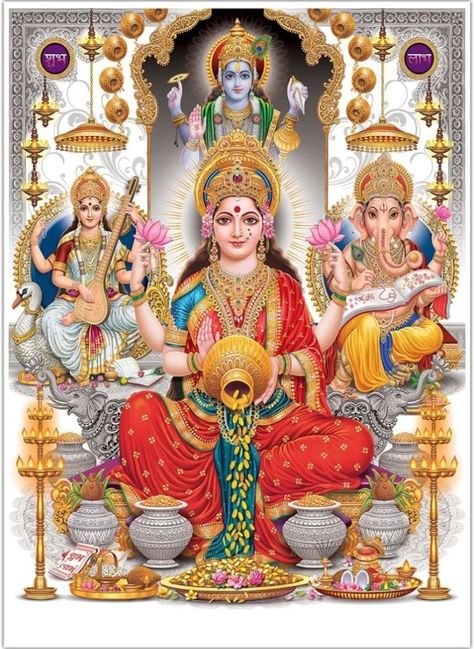
The Significance of Lakshmi in Hindu Thought and Culture
Lakshmi’s influence is not limited to festivals and rituals; her presence is intricately interwoven with the very fabric of Hindu thought, philosophy, and cultural traditions. Lakshmi, the embodiment of spiritual fulfillment, prosperity, and affluence, holds a central position in the Hindu pantheon, commanding the reverence and devotion of millions of believers.
Lakshmi and the Concept of Wealth
Lakshmi is not merely a symbol of material wealth in the Hindu worldview; rather, she embodies a comprehensive comprehension of prosperity that encompasses both the material and spiritual realms. It is believed that the goddess bestows not only financial abundance but also the wisdom and discernment necessary to utilize that fortune in a virtuous and meaningful manner.
The Hindu culture is profoundly rooted in the concept of Lakshmi as the provider of wealth, and her name and symbols are frequently invoked in the pursuit of financial success and entrepreneurial ventures.. Married women are referred to as “Shrimati,” a title that acknowledges them as the embodiment of Lakshmi’s bounties and the keepers of household prosperity.
Lakshmi and the Pursuit of Dharma
Lakshmi’s importance extends beyond material prosperity; she is also regarded for her contributions to the pursuit of Dharma, the ethical and moral path of life. The Purusharthas, which are the four fundamental objectives of human existence in Hindu philosophy, are Dharma, Artha (wealth), Kama (desire), and Moksha (liberation).
The four-armed iconography of Lakshmi is interpreted as a representation of the goddess’s capacity to assist her devotees in the harmonious pursuit of these four objectives. By paying tribute to Lakshmi, her devotees endeavor to establish a harmonious lifestyle in which material prosperity is balanced by spiritual wisdom and a dedication to ethical behavior.
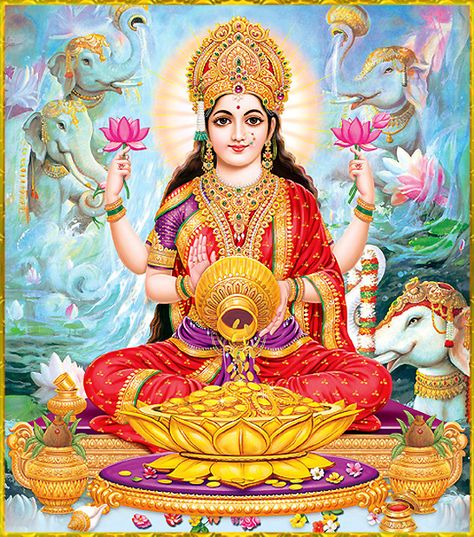
Lakshmi and the Concept of Feminine Power
Lakshmi is revered as the embodiment of the divine feminine in the Hindu tradition, representing the sacrosanct power and energy that sustain the cosmos. Lakshmi, the consort of Lord Vishnu, is regarded as the feminine counterpart to the masculine principal, collaborating to preserve the cosmic order.
Lakshmi’s veneration is not restricted to the Hindu faith; it has also permeated the spiritual traditions of Jainism and Buddhism, where she is acknowledged as a source of spiritual fulfillment, fertility, and affluence. This widespread veneration of the deity is a testament to the divine feminine’s universal appeal and her capacity to transcend religious boundaries.
The Legacy of Lakshmi in Art and Literature
The rich tapestry of art and literature that has emerged over the centuries, commemorating Lakshmi’s divine essence and the profound impact she has had on the cultural and spiritual landscape of the Indian subcontinent, is a reflection of her enduring presence in the Hindu pantheon.
Lakshmi in Hindu Art and Iconography
The goddess’s timeless allure and the profound reverence she commands are exemplified by the visual representation of Lakshmi in Hindu art and iconography. Lakshmi’s image has been meticulously documented in a variety of mediums, including the exquisite Tanjore paintings of the South and the ancient stone carvings of Sanchi and Bharhut. Each depiction reflects the distinctive artistic traditions and regional styles of the Indian subcontinent.
The lotus-seated Lakshmi, who is adorned in vibrant red and resplendent gold, has become an iconic symbol that adorns the walls of temples, the pages of sacred scriptures, and the homes of devotees. The goddess’s association with the divine feminine, prosperity, and abundance is further emphasized by the presence of the owl, the cornucopia of wealth, and the white elephants.
Lakshmi in Hindu Literature and Scriptures
The rich corpus of literary works that commemorate Lakshmi’s divine essence is also indicative of her prominence in Hindu thought and culture. The presence of Lakshmi is interwoven throughout the tapestry of Hindu literature, from the Vedas, the oldest sacred texts of Hinduism, to the Puranas and the great epics of the Ramayana and Mahabharata.
In the Rig Veda, the Shri Sukta is a hymn that is dedicated to Lakshmi and is regarded as one of the earliest textual references to the deity. It emphasizes her connection to spiritual fulfillment, wealth, and auspiciousness. As previously mentioned, the Garuda Purana offers a comprehensive account of Lakshmi’s three unique forms and their respective positions in the cosmic order.
Lakshmi is depicted in the Ramayana and Mahabharata in a variety of guises, notably as Sita, the virtuous consort of Lord Rama, and Rukmini, the cherished wife of Lord Krishna. These epic narratives not only demonstrate Lakshmi’s profound connection with her divine counterpart but also underscore the goddess’s multifaceted nature and her critical role in the preservation of dharma.
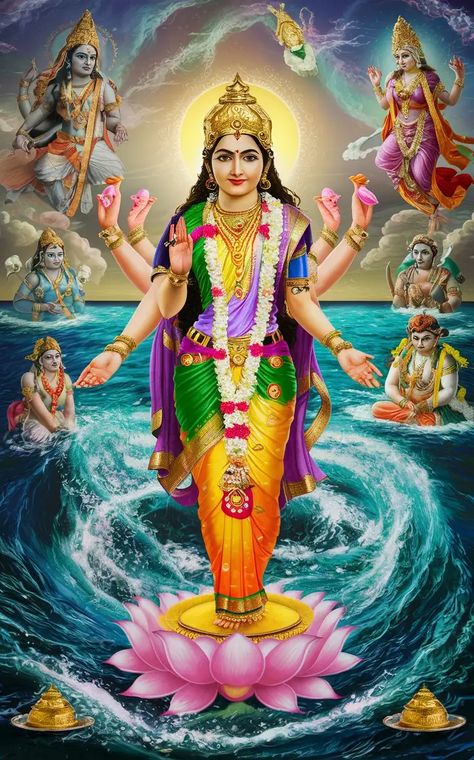
The Enduring Relevance of Lakshmi in the Modern Era
The eternal relevance of Lakshmi, the Goddess of Wealth and Prosperity, remains unwavering in the constantly changing modern world. The timeless wisdom and spiritual teachings associated with Lakshmi continue to resonate with devotees across the globe as people address the challenges of material progress and the pursuit of financial success.
Lakshmi as a Symbol of Balanced Prosperity
In an era characterized by the unwavering pursuit of material prosperity, Lakshmi’s teachings serve as a reminder of the significance of achieving a harmonious equilibrium between the spiritual and the material. Her four-armed iconography, which symbolizes the four Purusharthas, serves as a potent reminder that genuine prosperity is not limited to financial abundance, but also includes the cultivation of righteousness, the fulfillment of desires, and the ultimate liberation of the soul.
Devotees of Lakshmi endeavor to cultivate a mentality that acknowledges the inherent value of wealth and prosperity while maintaining the principles of ethical and virtuous living by paying tribute to her. This holistic approach to affluence and well-being is consistent with the increasing emphasis on sustainable development, social responsibility, and the integration of spiritual values in the contemporary world.
Lakshmi as a Source of Inspiration and Empowerment
Lakshmi’s enduring influence has transcended the confines of traditional Hindu practice in the contemporary era, providing inspiration to individuals from a wide range of backgrounds and beliefs. Lakshmi, a symbol of the divine feminine, has served as a source of inspiration and empowerment for women who aspire to emulate her attributes of grace, wisdom, and the capacity to sustain and nurture.
A revered figure among business leaders and professionals, the goddess is also associated with financial prosperity and entrepreneurial success, and they implore her blessings in the pursuit of their endeavors. Lakshmi’s universal and inclusive appeal transcends religious boundaries, thereby establishing her as a unifying force that commemorates the common human experience of pursuing spiritual enlightenment, fulfillment, and abundance.
Conclusion
The Hindu faith’s richness and complexity are exemplified by the Goddess Lakshmi, who is known for her captivating origins, multifaceted nature, and enduring legacy. Lakshmi’s influence has captivated the global imagination and inspired devotees, as she embodies the divine feminine, prosperity, and riches in the spiritual, cultural, and artistic landscape of the Indian subcontinent.
The timeless wisdom of Lakshmi continues to inspire her adherents, reminding them of the significance of balance, righteousness, and the pursuit of holistic well-being, through the rituals, festivals, and artistic expressions that honor her. The enduring relevance of Lakshmi’s teachings provides a pathway to a more harmonious and spiritually enriched existence as the modern world confronts the challenges of material progress and the pursuit of fulfillment.
May we discover the fortitude to resist the allures of greed, the wisdom to navigate the intricacies of the material world, and the grace to embrace the divine feminine as the guiding force that nourishes and sustains us all in the radiant glow of Lakshmi’s blessings.
#who #whois #lakshmi #whoislakshmi #history #origin #avatars

